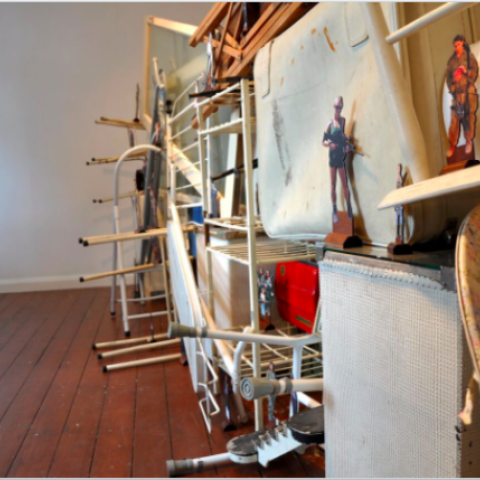l’étrangère
l’étrangère
44A Charlotte Road
London
EC2A 3PD
United Kingdom

Home Strike, guest curated by Alexandra Kokoli and Basia Sliwinska, brings together the work of four women artists — CANAN, Paula Chambers, Malgorzata Markiewicz, Su Richardson — in an exhibition exploring contemporary resistance to the persistent feminisation of domesticity and household maintenance. The exhibition interrogates those biopolitical and cultural norms that see women and their bodies systematically domesticated, exploited and imprisoned by patriarchal ideologies.
Oscillating between the horrific and the humorous, Home Strike revisits the domestic biopolitics of 1970s feminism. Through its contemporary inflection, the exhibition considers the impact of 1970s feminism on intersectional discussions of class, gender and global inequalities.
Paula Chambers’ practice involves weaponising everyday household objects, transforming them into instruments of self-defence, or violent revolt — a stark reminder that the home is often no safe space. Common cooking utensils have their handles wrapped in women’s tights and secured by colourful hairbands in Kitchen Shanks (2017), turning material supports of femininity into makeshift armaments. Exhibited on a security grille, the shanks allude to DIY weapons confiscated from prison wards, and often put on display to educate wardens. This depressingly implies that the female revolt may have already been suppressed — or else, it could illustrate that its insurgents are gaining ground and sharing skills. A rickety barricade of motley found or stolen furniture has been used to construct Domestic Front (2016). Both protective and defensive, the front is infested with small cut-outs of women with guns that are both real and imaginary, grotesque and idealised, from images Chambers sourced from the internet. In the artist’s own words, the installation “haunts our retrogressive imagination” through the use of “dysfunctional furniture and ambivalent ornamentation.”
The family home is Małgorzata Markiewicz’s battlefield. The artist targets the often glossed-over power struggles of family life, turning the tables on a mother’s obligation to nurture and cherish, whilst confronting the bourgeois expectation for women to entertain guests that simultaneously renders them as complicit objects of desire. Home Strike sees Markiewicz present a set of pristinely-designed boxes filled with the details of poisonous concoctions — more fitting for a witch than a hostess. On the current social position of women Markiewicz comments, “Things are going badly, to put it mildly.” In the video The Resistance Kitchen (2017), the artist, wearing a military double-breasted trench coat, offers her audience recipes for the deadly dishes — perhaps “the only tool of resistance available to women.” She calls for women to defend themselves and “join the resistance kitchen,” in a radical subversion of care-giving.
A pioneer of 1970s feminist art, Su Richardson plays a key role in revalidating craft, and its potential as a means of disrupting the white cube aesthetic. Simultaneously celebrating, exploiting and subverting feminine craft skills such as crocheting and embroidery, Richardson’s home-made objects stir the unconscious of domesticity and femininity and their mutual implications. The not-so-lovingly prepared fry-up of charred egg and sausage in Burnt Breakfast contrasts with the carefully crocheted technique Richardson has used to create the objects — emblematic of the artist’s ambivalence towards the traditional dos and don’ts of ‘home-making’. “Although we respect the skills passed on to us, they stink of poverty [...] your work was used, trodden on, or worn right out, like you yourself” - Kate Walker. In addition to Burnt Breakfast, Richardson is exhibiting a new body of work — a series of crocheted sculptures made for Home Strike that speak to the commodification of the female body, in its reduction to the role of either mother or sexual play thing.
Fountain (2000), a video work by Istanbul-based artist and activist CANAN, records the artist’s heavily lactating breasts filling the top half the screen, whilst milk drips audibly from her nipples. Fountain is an attempt by the artist to exorcise the phallic arrogance of Duchamp’s readymade, whilst also challenging the breezy irreverence of Bruce Nauman’s 1960s riff. Devoted to exposing the continuous and multi-faceted commodification and biopolitical exploitation of the female body, CANAN presents us with the ready-made’s diametric opposite: mother-made milk, both an ordinary and extraordinary product of postpartum mammals. The nakedness of her tumescent breasts stands in stark contrast to the images of femininity paraded before us in contemporary society: these are active, un-silenced producers rather than objects for the delectation of the male gaze.
